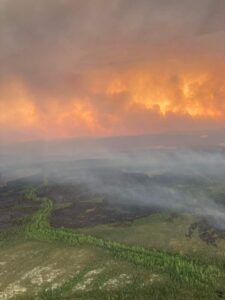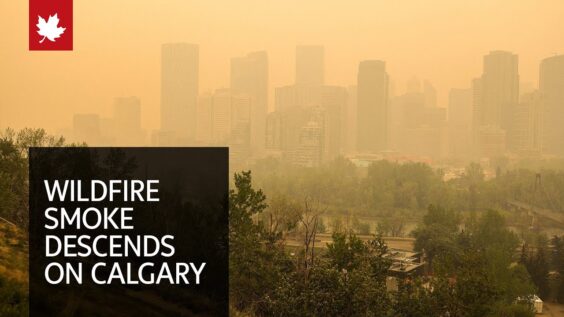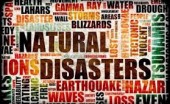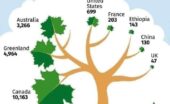Police treatment of a Dartmouth professor stirs anger and debate A retired Dartmouth Dean and good friend who lives in…
Canada natural disasters & climate 2023
Written by Diana Thebaud Nicholson // September 5, 2023 // Canada, Natural Disasters // Comments Off on Canada natural disasters & climate 2023
Emergency Preparedness – Disaster Survival Tips
Painting the Charlevoix
CBC Interactive:
(30 June 2018)
How to build wildfire-resistant communities in a warming world
Jeanne Homer, Associate Professor of Architecture, Oklahoma State University
(The Conversation) Designing for resiliency starts with risk assessments, particularly for communities in the wildland-urban interface – areas at the edge of forests and grasslands that are typically at higher risk of wildfires. Nearly half of Colorado residents lived in these areas in 2017, according to the Colorado State Forest Service.
From these risk assessments, communities can strategically plan and design safer developments.
Creating resilience in the wildland-urban interface involves several layers of defense.
At the community level, forest management, including thinning forests around communities and clearing away brush that could fuel a fire, is an important aspect of fire risk reduction and has become a priority for the federal government.
Carefully planning how land is used in communities can lower the risk to homes and property. A site’s vegetation types, weather and wind patterns, and slope of the ground can all affect how a fire spreads. Planning also ensures firefighters have road access to reach homes in all weather and identifies water sources for firefighting.
At the neighborhood scale, fire experts recommend maintaining an open area around housing developments in wildland fire-risk areas that is clear of tall grass and dense trees. These buffer zones could include mowed recreation fields, shopping area parking lots or other features that can slow a fire’s spread. (1 February 2022)
4 September
World on Fire: 2023 is Canada’s worst wildfire season on record — and it’s not over yet
Fires have scorched more than 15 million hectares across Canada this year
With choking smoke filling our skies in a summer that can only be described as unprecedented, no region of Canada has gone completely untouched by 2023’s devastating wildfire season.
More than 15 million hectares have gone up in smoke across the country this year, shattering the previous record of 7.6 million hectares in 1989 as well as the 10-year average of 2.5 million hectares.
And while the Labour Day long weekend may be the unofficial end to our Canadian summer, climate experts say it won’t be the end of the smoke or the flames.
18 August – 5 September
Yellowknife never had a plan for a city-wide evacuation
Leading up to last month’s wildfire evacuation, city said plan was for residents to shelter in place
The City of Yellowknife did not have a concrete plan for a full-scale evacuation of the N.W.T. capital before it was forced to put one into action last month.
“We were absolutely ready with our shelter-in-place plan. The whole concept of evacuating the entire city of Yellowknife is not something that’s contemplated in our emergency planning, nor actually in the GNWT’s [Government of Northwest Territories], either,” acknowledged city manager Sheila Bassi-Kellett, in a news conference on Monday.
The city’s weeks-long evacuation order will be officially lifted on Wednesday afternoon, meaning about 22,000 people will be making their way back home from Alberta, Manitoba, B.C., the Yukon and elsewhere.
In the weeks and days before the territory ordered the evacuation of Yellowknife, Ndilǫ, Dettah and the Ingraham Trail on Aug. 18, city officials said that if a wildfire threatened Yellowknife, the plan was to move people from the most at-risk sections of the city to other areas of the city, with the multiplex serving as an evacuation centre for those displaced.
City empties as thousands flee wildfire closing in on capital of Canada’s Northwest Territories
(AP) — Residents heeded warnings to evacuate the capital of Canada’s Northwest Territories as a wildfire burned toward the city of 20,000, while firefighters on Friday battled a growing fire that set homes ablaze in a city in British Columbia.
Feds say no one will be left behind in wildfire zone as military evacuation flights begin
First armed forces flight from Yellowknife transported 79 long-term care home residents to Edmonton
Hydro-Québec workers, vulnerable Cree community members evacuated due to wildfires
A Hydro-Québec spokesman said the public utility evacuated about 100 workers from the La Grande-3 dam in the James Bay region on Wednesday over concerns that roads or airports could get cut off.
Maxence Huard-Lefebvre said the situation has improved and that Hydro-Québec was evaluating Friday morning whether it was safe for its employees to return.
Homes destroyed, people trapped by fast-moving wildfire as thousands ordered to evacuate in B.C.’s Okanagan
1 August
As unprecedented fire year rages on, experts warn of longer, more destructive seasons
Large fires burning in Western Canada might last longer into fall, and even smolder through winter
(CBC) Should the coming years continue to break wildfire records for total area burned, it could end up changing the look and nature of Western Canada’s forests, possibly affecting industry and recreation.
According to Whitman, the forest fire researcher, if areas of Alberta’s boreal forest are repeatedly devastated, the trees in those spaces could change from dense collections of conifers to more spaced-out broadleaf species.
“In some cases, these areas that are very severely burned in a very short time period could convert into a sort of grassland,” she said.
“Those changes are going to affect the habitat on the landscape and the forests that are available for people to use.”
23 July
Canada’s wildfires blacken thousands of square miles, upend lives
Canada’s worst-ever wildfire season has choked much of North America with dangerous smoke for months, coupling with deadly heat around the globe in a summer that’s focusing the world’s attention on the perils of climate change.
By this week, some 42,000 square miles (109,000 square kilometers) had burned — an area roughly equivalent to the U.S. state of Virginia. About 900 fires were actively burning, with only about one-fifth considered under control.
Little reprieve for firefighters in B.C. as wildfire threat moves south
Hundreds of wildfires continue to burn in B.C, with some of the most concerning blazes now in the southern half of the province, as more international resources pour in to help with the fight.
The province is in the midst of a wildfire season that is already the worst on record when it comes to area burned, with 14,800 square kilometres charred as of 11 a.m. Sunday.
22 July
Historic flooding hits Nova Scotia amid torrential downpours
(CBC) Nova Scotia is reeling from a historic flooding event after significant rainfall swept over the province this weekend.
The heaviest rain fell across an area that stretches from Liverpool in Queens County on the South Shore, through Lunenburg County, then across to northwest Halifax County and into Hants County.
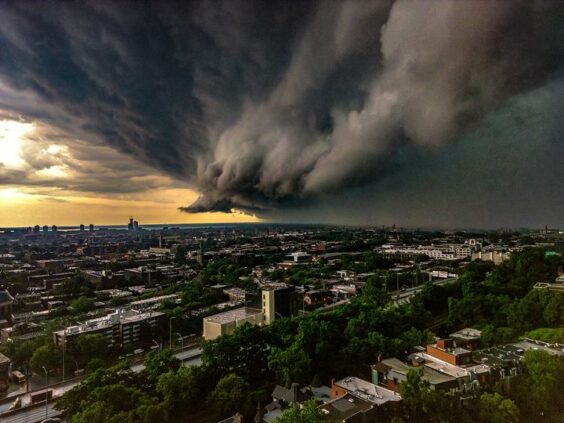
Tornado touches down in Mirabel as major storm wallops Greater Montreal
Environment Canada confirmed a tornado touched down near Mirabel airport, but there were no reports of injuries or damage.
11 July
Wildfires in Canada have broken records for area burned, evacuations and cost, official says
(AP) — Wildfires raging across Canada have already broken records for total area burned, the number of people forced to evacuate their homes and the cost of fighting the blazes, and the fire season is only halfway finished, officials said Thursday.
“It’s no understatement to say that the 2023 fire season is and will continue to be record breaking in a number of ways,” Michael Norton, director general, Northern Forestry Centre, Canadian Forest Service, said during a briefing.
A health expert also warned that smoke from the fires can cause health problems for people living in both Canada and the United States.
22 June
Canada, U.S. sign deal to better co-ordinate fight against wildfires
Agreement makes it easier for firefighters to pitch in on both sides of the border
Natural Resources Minister Jonathan Wilkinson and David Cohen, the U.S. ambassador to Canada, signed a memorandum of understanding Thursday meant to improve cross-border cooperation on wildfires.
The deal is designed to cut through red tape and bring together the agencies on both sides of the border that have a hand in fighting these destructive fires, which could become more frequent in the years ahead.
The deal also calls for better information-sharing so that both countries can stop a fire before it spirals out of control.
17 June
Australia’s volunteer ‘firies’ offer lessons on taming wildfires in Canada
Fire-prone Australia relies on mostly unpaid, local brigades to defend against disaster. Canada could look to them for lessons as climate change heats up
(Globe & Mail) In Canada, the majority of all firefighters are volunteers, but wildland fire management falls largely under the jurisdiction of provincial and territorial agencies that employ seasonal and full-time employees. However, with the country now experiencing its worst wildfire season of the 21st century, before even the start of summer, some agencies are actively exploring how they can bolster their wildfire response – and they could look to Australia’s community-based volunteers for lessons.
13 June
Is Canada ready for a fiery future? We tallied up all of its water bomber planes to find out
Aging planes need upgrading, but Europe is first in line to buy Canadian-made replacements
(CBC) The worst Canadian wildfire season of the century has tested the country’s airborne firefighting capacity, revealing that one of the most forested countries in the world may be ill-equipped to control fires raging simultaneously from coast to coast.
Aviation and emergency preparedness experts say Canada’s fleet of water bombers isn’t ready for that, partly because the country’s approach relies on sharing — both planes and firefighters — between provinces.That arrangement doesn’t work as well when fires are burning from east to west.
… Aviation analyst John Gradek [a lecturer and academic program co-ordinator in aviation management at McGill] says Canada has closer to 60 water bombers that he considers “quality” firefighting airplanes — high volume, high performance, fire-attack planes. He says the country needs to get about 40 more such water bombers over the next five to seven years to be prepared for what’s to come. “We have to invest in the fleet. We have an aging fleet.”
Canadair water bombers — the CL-215 and the CL-415, a later model,… have an international reputation as a tried-and-true aerial firefighting tool, but haven’t been made since 2015. Now De Havilland is preparing to build the next generation of Canadairs, the DHC-515 firefighter, at a plant planned for Calgary.
But if Canada wants to buy any, it will have to get in line. Selling for tens of millions of dollars a piece, the first 24 DHC-515s are all promised to Europe. Assuming the plant gets built on time and everything goes according to plan, those planes will be ready for delivery around 2027. De Havilland says the earliest any DHC-515s would be ready for Canadian customers would be around 2029 or 2030. But so far, no provinces or territories have ordered any.
12 June
Nearly 350 firefighters from the E.U. will help battle relentless Canadian wildfires
A battalion of nearly 350 firefighters from the European Union will soon be on the ground in Quebec to help their Canadian counterparts tackle a devastating and unprecedented wildfire season.
One hundred and nine firefighters from France arrived last Thursday and spent the weekend dousing flames in Quebec, where fires have forced nearly 14,000 people to flee their homes.
Another 140 reinforcements from Portugal and 97 from Spain are due to arrive in Quebec City on Wednesday, said Claire Kowalewski, the European Union Emergency Response Coordination Centre’s liaison officer in Canada.
It’s the first time in the centre’s 22-year history that it has sent firefighters to help in Canada, Kowalewski said.
‘Worst wildfire season’: Quebec makes progress as wind fuels flames out West
Nearly 32,000 people remain out of their homes countrywide because of smoke and raging wildfires
Quebec is on the offensive in its battle against a record wildfire season as gusting winds fuelled growing blazes out West — and the federal government said it would provide free travel documents and visa extensions for people affected across the country.
“This now qualifies, unfortunately, as Canada’s worst wildfire season of the 21st century,” Emergency Preparedness Minister Bill Blair said in Ottawa.
There were 431 wildfires burning across Canada on Monday afternoon and more than 200 were listed as out of control
About 5,000 firefighting personnel have been deployed. Hundreds more firefighters from Chile, Costa Rica, Spain and Portugal are expected to arrive in the coming days.
9 June
U.S., Canada open to a ‘NORAD-like’ model of joint disaster response: [Emergency Preparedness Minister Bill] Blair
Cross-border co-operation must respect provincial responsibility, emergency preparedness minister says
In an interview with CBC’s The House airing Saturday, Blair said he’s spoken with the head of the Federal Emergency Management Agency (FEMA) — America’s federal disaster response force — on how to better cooperate in responding to major natural disasters.
“We’ve been talking about even a NORAD-like approach,” he said. “Because these emergencies of wildfires, floods, earthquakes, emergencies writ large and all hazards — they’re borderless.”
A visual guide to the Canada wildfires and US smoke pollution
There are more than 400 fires burning across Canada, with many out of control, and as smoke travels south it is prompting air quality alerts in the US
by Oliver Milman, Maheen Sadiq, Lucy Swan, Seán Clarke, Harvey Symons and Paul Scruton
(The Guardian) Where are the fires and why are they so bad?
There are more than 400 wildfires burning across Canada, with many out of control, according to officials. The fires are unusual in their timing, size and location. The “fire season”, when weather conditions are ripe for conflagrations, has only just begun. A third of the fires are in the boreal forest in the eastern province of Quebec, a place not used to dealing with large blazes.
Fires are now burning in every Canadian province except for Prince Edward Island and Nunavut, a frigid northern region where trees cannot survive. The amount of land consumed is also striking – more than 4.4m hectares has burned so far this year (2.7m since the start of the fire season).
Why did the sky above New York turn orange?
The city’s sky turned from milky white to a dystopian tangerine on Wednesday, bringing with it a smell similar to a campfire. The hazy skies were caused by plumes of smoke from the Canadian fires when winds funnelled the haze first to Ottawa and Toronto and then directly into many of the major population centers of the US east coast.
With wildfires affecting every community in her nation, Grand Chief and Chairperson of the Cree Nation Mandy Gull-Masty fears Quebec’s new French-language law will complicate relief during natural disasters
7 June
Feds looking at options for a national disaster response agency as wildfires rage
The federal government is studying options for creating a new national disaster response agency.
The discussions come as Canada is experiencing its worst wildfire season in history and after governments once again had to call on the military to step in and help.
Earlier this week, Prime Minister Justin Trudeau said the government is heavily focused on getting through this difficult fire season but that “absolutely” discussions need to be had about how to be better prepared as climate change makes fire seasons like this one more likely.
“We have since 1982 had CIFFC, the Canadian Interagency Fire Fighting Centre, that has over the past years grown in importance and relevance,” he said Monday.
“We continue to work with it. … As we know, climate change is going to bring more extreme weather events in the future, more dangerous floods, more difficult and devastating wildfires, more intense hurricanes and storms. We are going to need to continue to step up in our support for Canadians.”
A senior government source told The Canadian Press that discussions on a new approach are already well underway and include analyzing the merits of creating a Canadian version of the Federal Emergency Management Agency in the United States.
The agency or team would not just be for fires but for all disasters, including flooding and major storms, such as hurricanes.
Canada’s disaster response plans currently involve different levels of government on a case-by-case basis. They repeatedly turn to the Canadian Armed Forces to deploy soldiers and equipment to help.
When the military responds in Canada, that work falls under Operation Lentus.
5 June
Canada on track for its worst-ever wildfire season
(Reuters) – Canada is on track for its worst-ever year of wildfire destruction as warm and dry conditions are forecast to persist through to the end of the summer after an unprecedented start to the fire season, officials said on Monday.
Blazes are burning in nearly all Canadian provinces and territories, and federal government officials said their modeling shows increased wildfire risk in most of Canada through August.
Wildfire risk remains well above average across Canada this month
(Canadian Press) An area of land 11 times bigger than the city of Toronto burned from wildfires in the last four days — Canada’s worst spring wildfire season to date.
Another 389 fires were recorded since June 1, and as of Monday morning there were 413 active fires underway, with the risk having spread to more provinces over the weekend.
Nearly 250 of those were out of control in nine provinces and two territories.
Mike Norton, the director general of the Northern Forestry Centre at the Department of Natural Resources, said having this many fires from coast to coast at this time of year is not normal.
And the outlook for the rest of the season remains dire.
Wildfire preparedness and response must include planning for unhoused people and other vulnerable populations
Holly Mathias, PhD student, School of Public Health, University of Alberta and Ashleigh Rushton, Postdoctoral Fellow, Health Sciences, University of The Fraser Valley
(The Conversation) The 2023 Canadian wildfire season is off to a roaring start. In Alberta, there have been more than 560 wildfires so far — the highest recorded number of fires since 2018, and the season has only just begun. Tens of thousands of residents have been evacuated and a state of emergency was declared across the province.
Wildfires are not new to the region. The 2016 Horse River/Fort McMurray Wildfire was the worst wildfire and most costly disaster in recent Canadian history. Meanwhile, on the opposite side of the country, Nova Scotia has already experienced a historic 200 wildfires, resulting in a local state of emergency in Halifax Regional Municipality and more than 25,000 displaced residents.
Our concern as researchers is that there is an alarming lack of international, national and provincial plans or guidelines that consider the unique risks and needs of unhoused populations during wildfires.
What is apparent is that response often falls on service providers who support the unhoused, despite adequate housing being an international human right that should be the responsibility of the government.
1 June
Firefighters from U.S., South Africa to battle Canada’s ‘unprecedented’ fires
(CTV) A massive amount of land has already been scorched by wildfires in Canada this year, and federal fire officials warn the hot, dry weather fuelling the burns is nowhere near over.
The unusually severe start to fire season is prompting warnings to Canadians to know their risk and concerns about a shortage of firefighters as many jurisdictions are now in competition with each other for the number of trained workers available.
“These conditions this early in the season are unprecedented,” said federal Emergency Preparedness Minister Bill Blair.
He said the amount of land already burned is more than 10 times the average amount of land burned by June 1 over the last 10 years.
As the situation in Alberta grew quickly out of control in early May, the Canadian military moved in to help, and the Canadian Interagency Forest Fire Centre also helped commission firefighters from other provinces and other countries.
But federal officials said in a briefing to reporters Thursday that the fire situation is troublesome almost everywhere now, and those provinces need their staff back at home.
29 May
Northern B.C., Alberta and all of Ontario under ‘high’ to ‘extreme’ wildfire risk: What to know
(CTV) Wildfires have burned more than2 million hectares of land across Canada so far this year, during what has been one of the earliest fire seasons on record.
According to the National Wildland Fire Situation Report, the fires in Yukon, B.C. Alberta, Northwest Territories, Saskatchewan and Manitoba are among the nearly 1,600 recorded so far this year.
Thousands evacuate as Nova Scotia fights wildfires
Fire risks high in Quebec as hot, dry weather intensifies
25 May
How wildfires are changing in Canada
There are fewer fires, but an increase in area burned and number of people displaced
The wildfires that have ripped through parts of the Maritimes and Western Canada this spring are part of an overall rise in more powerful fires, experts say. But the details behind this trend are more complex than just counting the fires, or damage done, per year.
21 May
Boots on the ground, eyes in the sky: satellites increasingly used to fight wildfires
(CTV) The last decade has seen a huge jump in the number Earth observation satellites, driven by cheaper technology and the entry of private industry.
One of the most useful readings from satellites is called fire radiative power, a measure of how much energy a fire is emitting. That tells fire managers where the hot spots are, where it’s most likely to advance and how quickly.
Knowing how hot a section of the fire is can also suggest how best to fight it, Flannigan said.
“You can tell if dropping water or fire retardant on that part of the fire would work or if you’d be wasting your time.”
What’s more, knowing how hot the fire is burning allows scientists to calculate what it is putting into the atmosphere. Forecasters use the European Space Agency’s Sentinel satellites to figure out a vast range of emissions, from greenhouse gases to particulates to carbon monoxide.
18-19 May
A ‘Canadian Armageddon’ Sets Parts of Western Canada on Fire
Wildfires raging in Alberta and British Columbia have created a sense of panic and fear, and forced thousands of residents to evacuate from their homes.
(NYT) Climate research suggests that heat and drought associated with global warming are major reasons for the increase in bigger and stronger fires.
Amid frequent fire updates dominating national television news broadcasts, the blazes have also helped unite a vast and sometimes polarized nation, with volunteers, firefighters and army reservists from other provinces rushing in to lend a hand.
Canadian forest fires are the latest costly climate disaster that public accounts fail to capture
The advantages of fighting in-your-face effects of climate change simply don’t show up public accounts
You don’t have to tell the people of Calgary and other Canadian communities breathing orange air that forest fires have a cost.
And while repeated studies draw a direct line between an increase in costly forest fires and climate change, economists and accountants right up to Canada’s Parliamentary Budget Officer say the benefits of stopping climate change and thus reducing the many harms it creates are simply impossible to measure for public accounting purposes.
While federal budgets include all the costs of fighting climate change, the other side of the ledger, the notional income from the benefits of you not breathing smoke, or at least breathing less, remain blank. Since there is no benefit, it is harder to justify spending the money.
For Dave Sawyer, principal economist with the Canadian Climate Institute, the costs of climate change in our daily lives are obvious, including from the current forest fires.
“The particulate matter exposure and the air quality is serious,” said Sawyer on Wednesday. “There’s going to be a spike in deaths. There’s going to be a spike in morbidity outcomes, hospital visits, respiratory illness.”
17 May
Hotter, faster, more destructive: wildfire’s new reality (audio)
(CBC Front Burner) Author John Vaillant is watching it unfold with a terrifying comprehension of the science of these super fires and just how dangerous they can be. He has spent years investigating what happened in 2016 when parts of Fort McMurray burned to the ground. His new book, ‘Fire Weather: The Making of a Beast,’ explains why the fires we battle today are hotter, faster and more destructive than the fires of before.
He joins Alex Panetta for a conversation about the future of fire in our changing climate.
15 May
Shifting winds threaten to fan the flames of Alberta wildfires
Once sleeping giants, Alberta’s wildfires are threatening to show the full extent of their power.
High temperatures have been unrelenting in recent days and no rain is in the forecast. While temperatures will ease somewhat in the week ahead, the changing forecast is expected to bring new dangers.
As of Monday afternoon, 91 wildfires were burning across the province, both inside and outside Alberta’s forest protection areas. Of the 85 wildfires burning inside those areas, 23 are classified as out of control.
14 May
Heat wave challenges firefighters in B.C. as new wildfires prompt evacuations
Northeastern B.C. continues to see large wildfires burn out of control, as unusually hot weather challenges firefighters.
(CBC) The hot conditions are adding to extreme drought in the Peace region of northeastern B.C., where the biggest fires are burning. Additional firefighting resources are being dedicated to what is being called the North Peace Fire Complex, consisting of four large fires.
Chile’s firefighting goats protect a native forest from deadly blazes
(Reuters) – In the southern Chilean city of Santa Juana, hit hard by wildfires earlier this year, locals have a special taskforce helping fight blazes: a herd of goats.
The goats have already saved the native forest of the Bosques de Chacay once, preventing the park from being consumed by February forest fires. The technique, also used in Portugal and Spain, relies on grazing goats to control dry pastures and other vegetation that fuel forest fires in the summer. Goat droppings also help enrich the soil and prevent further erosion.
11 May
Government of Canada releases first national-level disaster risk assessment
/CNW/ – The rising frequency and severity of natural disasters is a growing concern. In recent years, Canadians have seen extreme weather events, like floods and wildland fires, destroy homes, businesses, and critical infrastructure, and leave lasting impacts on communities right across the country. As Canada and the world continue to experience these disasters, it is crucial to increase risk awareness across all sectors of society and to inform decision-making for reducing, preparing for, and responding to them.
Today, the Honourable Bill Blair, President of the King’s Privy Council for Canada and Minister of Emergency Preparedness, released the National Risk Profile (NRP), Canada’s first public, strategic, national-level disaster risk assessment. It provides a national picture of disaster risks facing Canada, and the existing measures and resources in our emergency management systems to address them. “The NRP is Canada’s first strategic, national-level risk assessment. This report is based on input and evidence from whole-of-society stakeholders across Canada, and provides a foundation for understanding disaster risk from the three costliest hazards facing Canadians: earthquakes, wildland fire, and floods. It aims to broaden public awareness of disaster risk, identify gaps in the Canadian emergency management system at a national level and provide evidence to support existing federal risk assessment and climate change adaptation efforts. This evidence base can help reduce disaster risk and increase resilience for everyone in Canada. ” The First Public Report of the National Risk Profile
Canada ill prepared for a major earthquake, new disaster risk profile warns
The first draft of a new national disaster risk assessment report warns that a major earthquake in British Columbia or parts of Ontario and Quebec could swiftly become the most costly natural disaster Canada has seen.
It says there are major gaps in Canada’s earthquake response plans, including limited information on the risks and how to prepare for them.
The national risk profile published Thursday morning is the government’s first attempt to identify the biggest threats Canada faces from natural disasters and to find ways to limit the possible damage.
Note: “An added note on the potential for earthquakes in the Montreal region: I was recently informed by a geologist, that there is a very dangerous situation in the Montreal area that I believe is called a, three way fault (the intersection of three different fault lines). In this case, the intersection of the Great Lakes, Ottawa and St. Lawrence River Faults…all of which ironically come together under the Field of Honour in Pointe Claire. (The Fukushima area in Japan was devastated by a three way fault that occurred under the sea some distance from shore some years ago).” J.A.
10 May
Forest fires: North America’s boreal forests are burning a lot, but less than 150 years ago
Victor Danneyrolles, Professeur-chercheur en écologie forestière, Université du Québec à Chicoutimi (UQAC); Raphaël Chavardès, Postdoctoral fellow, Université du Québec en Abitibi-Témiscamingue (UQAT); Yves Bergeron, Professeur écologie et aménagement forestier, Université du Québec en Abitibi-Témiscamingue (UQAT)
(The Conversation) Unseasonably hot and dry weather conditions in early May 2023 led to dozens of forest fires in western Canada. As of May 6, the Alberta government declared a state of emergency over wildfires, and at the time of writing this article, nearly 30,000 people had to be evacuated. Although it is too early to establish a precise assessment of this extreme episode, recent research allows us to place it in a broader context.
The results of our research contradict the common wisdom about North American boreal forests — that they burned more in the past than they do today.
What causes a forest fire?
Scientists have been asking this question for a long time. Thanks to research carried out in the last few decades, the answer can now be summed up by three factors: vegetation, weather, and triggers.
7 May
Ontario sends crews to help wildfire-besieged Alberta
Forty Ontario-based firefighters were sent to Alberta Saturday to help battle blazes across the province, along with four task force leaders and two command officials, according to centralized data.
They were joined by firefighters from Quebec and firefighting aircraft as Canadian wildfire responses coalesce behind local crews in wild rose country.
The information comes from the Canadian Interagency Forest Fire Centre (CIFFC), a non-profit organization owned and operated by Canada’s national and provincial wildland firefighting agencies. It exists to coordinate responses to emergencies like the one in Alberta.
Canadian Interagency Forest Fire Centre
CIFFC is a not-for-profit corporation owned and operated by the federal, provincial and territorial wildland fire management agencies to coordinate resource sharing, mutual aid, and information sharing. In addition, CIFFC also serves as a collective focus and facilitator of wildland fire cooperation and coordination nationally and internationally in long-range fire management planning, program delivery and human resource strategies.
Close to 30,000 people now displaced as Alberta continues battling wildfires
Evacuations grow as province gets help from B.C., Ontario and Quebec
A change in weather conditions has helped firefighters fight the wildfires that have forced thousands of Albertans to flee their homes this past week, officials from the Alberta Emergency Management Agency and Alberta Wildfire said Sunday.
“Today we’ve seen some light scattered showers in the southern part of the province, as far north as Fox Creek. The good news is that it did have an impact on fire behaviour today in that area,” Christie Tucker, information unit manager with Alberta Wildfire, told an afternoon news conference in Edmonton.
“It allowed firefighters to get a chance to work on the areas of some wildfires that they haven’t been able to get close to because of extreme wildfire behaviour.”
While the province is battling fires using air tankers and helicopters, Tucker said the change in weather conditions has been most beneficial to firefighters on the ground.
2 May
Flooding forces hundreds of evacuations as Quebec towns declare states of emergency (See drone footage)
People have had to leave their homes and roads have been washed away in the Charlevoix region of Quebec.
Hundreds of people have been evacuated from their homes and several towns have declared states of emergency after torrential rains spiked river levels and led to widespread flooding in Quebec.
At least three municipalities are under a state of emergency Tuesday after flooding caused by heavy rain: Baie-Saint-Paul, which is located about 100 kilometres northeast of Quebec City in the Charlevoix region, as well as Saint-Côme and Sainte-Émélie-de-l’Énergie, which are in Lanaudière, north of Montreal.
Environment and Climate Change Canada (ECCC) recorded about 56 millimetres of rainfall in Baie-Saint-Paul, Monday.
The Lanaudière region, northeast of Montreal, was also hit hard by flooding.
Parts of several towns and villages, including Saint-Côme, Chertsey, Rawdon and Sainte-Émélie-de-l’Énergie, were overwhelmed by rising waters.
Several roads flooded in the Laurentians, north of Montreal, threatening to cut off emergency access to some areas.
The Lac-Théodore area in Val-Morin was one such area. Residents there were in danger of being cut off entirely as access roads flooded. Town officials urged residents to leave their homes, warning that those who decided to stay would be cut off from emergency services.
Part of this centuries-old Quebec farm has been swallowed, maybe permanently, by the river
Farmers in Baie-Saint-Paul are tallying the losses after this week’s deluge
The fields that had been ready for another season of wheat, corn or oats are now covered with sand and clay.
… Unsure if he can recoup his losses, Méthot is one of the farmers in the region left reeling from the flooding and heavy rainwaters that hit the region on Monday.
Not only will this hurt his bottom line, but Méthot says the weather event could threaten Charlevoix’s agricultural scene — a part of the region’s heritage.
Méthot was drawn to to the Charlevoix region by its agricultural history and its renowned cheese, meat and milk products. He says now, that has “eroded away.”
“Agriculture is important in itself but that’s bigger than just agriculture. It’s part of the heritage of Charlevoix. It represents what Quebec is, in the hearts and minds of a lot of people. When you drive around, when you look around, when you taste [products],” said Méthot
4 May
Before the flood, Baie-Saint-Paul, Que., was best known for art. Now local artists are picking up the pieces
Devastating damage happened just weeks before tourist season set to start
Everist Prokofiev, an artist and gallery owner in Baie-Saint-Paul, says he moved to the region from Ontario 13 years ago because of the art scene.
“Baie-Saint-Paul is such a mecca for art and has been for almost 100 years,” said Prokofiev. “So with something like this happening here in Baie-Saint-Paul, it’s sad and it’s kind of nerve-wracking because their season is about to start.”
Carrying art from 15 Canadian artists in the gallery, once the news got out about the flooding, Prokofiev said he started fielding calls from Newfoundland to British Columbia. Although no art was damaged, he suspects the flood will cost him thousands of dollars.
“We could not get insurance for water damage of any kind,” said Prokofiev, adding that his property is along a floodplain.
2023 Canada ice storm
On April 5, 2023, the 2023 Canadian ice storm devastated Quebec and Ontario, knocked out electricity for more than a million people, resulted in fatalities, and severely damaged property and infrastructure.
6 April
Two dead, over a million without power after ice storm hits Canada
(Reuters) – Two people died and more than a million were without power on Thursday after an ice storm hit Canada’s two most-populated provinces ahead of a holiday weekend, bringing freezing rain and strong winds that toppled trees and weighed down power lines.
Just under a million people did not have power in Quebec and about 110,000 in Ontario as of 4 p.m. (2000 GMT), according to Poweroutage.com. Outages combined for both provinces had crossed at least 1.3 million earlier in the day.
